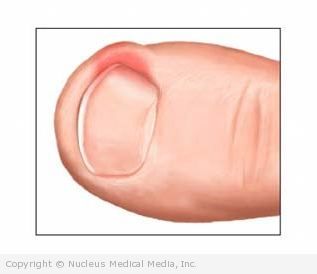Paronychia – Definition
Paronychia is inflammation of the skin that surrounds a fingernail or toenail. It may be acute or chronic and is most commonly caused by infection with either bacteria or fungi.
Paronychia – Causes
Paronychia occurs when a bacteria or fungus enters damaged skin surrounding the nail. The damaged skin can be torn cuticles, cuts, or cracks.
Paronychia – Risk Factors
A risk factor is something that increases your chance of getting a disease or condition.
The risk of paronychia increases with:
- Diabetes
- Work that requires frequent exposure to chemical solvents or water (eg, food service, cleaning, dentistry, bartending, hairdressing, nursing)
- Habitual nail-biting
- Overly aggressive manicuring
Paronychia – Symptoms
Symptoms include:
- Redness and swelling of the skin around the nail
- Pus formation near the nail
- Pain and tenderness to the touch
- Discoloration or ridging of the nail
- Absence of the cuticle
Paronychia – Diagnosis
The doctor will ask about your symptoms and medical history, and perform a physical exam. If there is pus, your doctor may recommend that you have it drained. You should not try to drain the pus yourself. Your doctor may send a sample of the pus to the lab for testing.
Paronychia – Treatment
Treatments are different for acute and chronic paronychia.
Acute Paronychia
A mild case of acute paronychia (minor swelling or redness near the nail) may be treated by soaking the affected nail in warm water. This treatment can be repeated 2-4 times daily, for about 15 minutes each.
In most cases, this type of paronychia heals within 5-10 days. If your condition does not improve, your doctor may prescribe oral antibiotic medication. In cases where an accumulation of pus (abscess) is suspected, your doctor may also cut the area with a scalpel to drain it.
Chronic Paronychia
Since some chronic cases might be caused by fungi, your doctor may give you an antifungal medication—perhaps in a liquid formulation called ciclopirox, which is applied directly to the infected area. Studies have shown that oral treatment for fungi does not produce better results than simply applying cortisone cream (see below).
Chronic paronychia may also be caused by a mixed bacterial infection which can be treated with antibiotics. You may need to take the medication for several weeks. Some dermatologists believe that chronic paronychia is often caused by inflammation rather than by either bacterial or fungal infections. For such non-infectious paronychia the use of cortisone creams can be helpful.
Whatever treatment is prescribed, it is important to keep the skin clean and dry. It is also important to avoid getting irritating substances, such as strong cleaners or certain foods, on the area. Surgery may be recommended in some cases of chronic paronychia that do not respond to other treatments.
Symptoms may subside with treatment. However, permanent damage to the nail or surrounding tissue sometimes result.
Paronychia – Prevention
To help prevent paronychia:
- Keep your hands and feet clean and dry
- Wear rubber gloves if your hands are routinely exposed to water or chemicals
- Avoid biting your nails
- Avoid cutting, pulling, or tearing your cuticles
- Avoid artificial nails, vigorous manicures, or treatments that remove the cuticles
- If you have diabetes, maintain your blood sugar levels as close to normal as possible
- Practice proper hygiene. Do not share bathroom supplies (towels).

